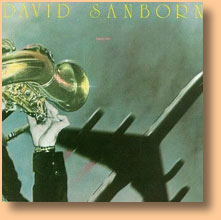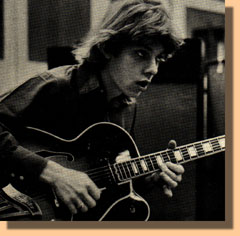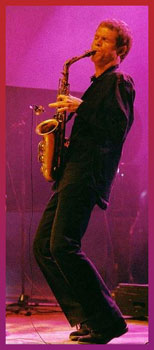

|
Soundclip:
|
| See Steve's Hand-Written Lead
Sheet |
|
Steve
Khan's
lead
sheet:  The band consisted of a list of close friends, and very solid musical connections, which would include: Buzzy Feiten: Guitar; Don Grolnick: Keyboards; Will Lee: El. Bass; Rick Marotta: Drums; Chris Parker: Drums; Ralph MacDonald: Percussion; all played live with a small horn section, which, of course, included, Randy Brecker and Michael Brecker. And yes, you read this correctly, we played my two tunes with two drummers! Just to keep the festivities under control, we were to be under the watchful eye of arranger, Dave Matthews. As it turned out, David Sanborn was to re-title both of my tunes! "Mr. Butterfat" became just "Butterfat" and, the horrific title of "Do the Grunt" became "Duck Ankles." In various contexts, we had been playing these tunes for quite some time, so it felt very natural to be recording them together. The band consisted of a list of close friends, and very solid musical connections, which would include: Buzzy Feiten: Guitar; Don Grolnick: Keyboards; Will Lee: El. Bass; Rick Marotta: Drums; Chris Parker: Drums; Ralph MacDonald: Percussion; all played live with a small horn section, which, of course, included, Randy Brecker and Michael Brecker. And yes, you read this correctly, we played my two tunes with two drummers! Just to keep the festivities under control, we were to be under the watchful eye of arranger, Dave Matthews. As it turned out, David Sanborn was to re-title both of my tunes! "Mr. Butterfat" became just "Butterfat" and, the horrific title of "Do the Grunt" became "Duck Ankles." In various contexts, we had been playing these tunes for quite some time, so it felt very natural to be recording them together.Though I can't remember exactly when it was, I do remember the first time I saw Buzzy Feiten play live. It was at New York's premiere music club, "The Bottom Line" and he was playing there with Bonnie Bramlett. What I remember most about that night was a short introduction that Buzzy played to one of the tunes, a shuffle. Wow, it was really spectacular, but very funky and with simple chords on his Fender Stratocaster. If was not long after that show that I went back home and sought to compose something loosely based upon that "Intro" which I had heard him play. And this is what became, "Mr. Butterfat." Of course, because in those years, Buzzy was always pretty 'wired', when I told him this story, as we were rehearsing the tune for Sanborn's record, he had no recollection of what he might have played with Bonnie Bramlett that lost night, and didn't think that my tune could possibly have been inspired by him. But, he was very flattered by it all. We seemed to really have a lot of fun playing together, and we had already recorded in tandem on a then recent Felix Cavaliere LP titled, "DESTINY"(Bearsville). Felix was an absolutely wonderful person to work with, we had many great times on this project and others. Buzzy's soloing on the tune "Flip Flop" is 'classic Buzzy' to these ears. Unfortunately, a lot of what he played in the Fade was not used. On a side note, when my then young son, Heath, met Buzzy, he couldn't really say his name, and he used to call him: "Buddy Fee." I still smile when I think about that! As a piece of music, "Mr. Butterfat" is painfully simple. And what could be more simple than a tune, written by a guitarist, that's based around a funky rhythm part on an E7(9) chord? There is a short 8-bar Intro, which we used to play live with only my guitar for 4-bars, and then the rhythm section would join in. But for this recording, it was decided that Sanborn would play a solo sax lick out front and then, we all hit it right at the top. From there, there is a very simple and repetitive [A] melody section where for 8-bars the theme is stated in unison, and then for another 8-bars some harmony and the horn section was added.  Letter [B], to me, is a classic section of good old R&B harmony which, of course, 'takes it to the bridge' and the IV chord area of A major, with a little dose of the relative minor F# thrown in for good measure!!! Then, there is a reprise of the [A2] melody for just 8 bars and it's right into Sanborn's solo. On a cue out of his solo, we return to [B] and then fade out on [A2]. All of that barely takes up 3-minutes. Of course as fate, or dumb luck would have it, the tune became an immediate instrumental 'hit' for David Sanborn, and he grew to dislike it greatly. I guess success can be, in some form, a curse. It is all so ironic because Paul Shaffer adores this tune, and one hears it with some regularity going into the commercial breaks of the "THE LATE SHOW with David Letterman." Letter [B], to me, is a classic section of good old R&B harmony which, of course, 'takes it to the bridge' and the IV chord area of A major, with a little dose of the relative minor F# thrown in for good measure!!! Then, there is a reprise of the [A2] melody for just 8 bars and it's right into Sanborn's solo. On a cue out of his solo, we return to [B] and then fade out on [A2]. All of that barely takes up 3-minutes. Of course as fate, or dumb luck would have it, the tune became an immediate instrumental 'hit' for David Sanborn, and he grew to dislike it greatly. I guess success can be, in some form, a curse. It is all so ironic because Paul Shaffer adores this tune, and one hears it with some regularity going into the commercial breaks of the "THE LATE SHOW with David Letterman."From a guitar perspective, and this tune is painfully much too rooted in the guitar and its mannerisms, it is worth looking at the Intro figure. The trick to playing the 'feel' correctly for that simple E7(9) voicing is that it has the slightest bit of 'swing' to it. From a harmonic perspective, on the last two beats of the 2nd bar of the figure, you can see that I used an unusual voicing for such a groove as I briefly hit upon D7(sus) to E7(sus). Both voicings are played with the root note on top. Again, in my mind, I am certain that I stole this idea from something that Buzzy Feiten improvised that lost night at the Bottom Line. The chords to the [B] section are, in essence, made-up of the most basic major and minor triads, just the way "good old" R&B has always been played. Yes, there are a couple of more lush sounding 9sus chords used, but they are in character too. It's interesting that it felt better to us to clip-off two beats and to make the 8th bar of this section a 2/4 bar before a drum fill leading to [A2]. I can't say that I ever understood just why David insisted on adding a wah-wah to his wonderful alto sax sound, but for some reason, that's what he decided to do. It was done after the fact, and I recall seeing him sitting there at the console and moving his foot over the Vox Wah-Wah pedal as his principle track was then recorded with the effect, but on a separate track. I still don't understand that one!  Another great memory, which I associate always with this tune, is walking into Studio A-1 of A&R some years later to play on a Billy Joel recording, and, as I entered, Billy and his bandmates looked at one another, and then launched into a rip-snortin' version of "Mr. Butterfat." Needless to say, I was totally surprised by this most sincere form of a compliment. When they concluded, Billy told me, "Wow man, we just love that tune of yours, 'Butterfat' from Sanborn's record!!!" I looked at him, and I then responded by saying: "You know, the title of that tune is actually 'Mr. Butterfat.'" And we all began to laugh. However, from that point forward the word "Mr." was added to the front of everything, and became the 'inside joke' for that recording, and well beyond it. For years afterwards, people constantly ask me about the "THE STRANGER" and "52nd St." and wonder, "Why are you the only musician credited as: Mr. Steve Khan?" Well, now you know! Over the years, I have always felt very grateful to David Sanborn for his faith in me and in my humble little tunes. I am really glad that I was able to play a small role in the launching of his career. As his longtime friend, I am most proud of what he has been able to accomplish. I suppose it's not so surprising that he has become the most imitated alto saxophonist of his generation. Some of his shameless imitators, in some sense, have actually become bigger sales magnets. This is absolutely remarkable to me. But, standing alongside David all those years, whether we were part of the Brecker Bros. Band or my occasional role as a sideman in one of his touring groups, it was always easy to feel that he had the capacity to reach people, to move people. I hope that everyone enjoys having this view of my first recorded tune. Happy New Year 2007!!! Addendum: In the analysis for "Some Down Time" from "THE BLUE MAN" recording, I mentioned that unfortunately, due to my own naïveté and complete lack of self-confidence, I allowed myself to be bullied into giving-up the copyrights and the publishing to both "Mr. Butterfat" and "Duck Ankles" to the dishonest and unscrupulous producer of "TAKING OFF." I had good friends around me, begging me not to sign those papers, assuring me that it was easy for someone, anyone, to have their own publishing company, but I was afraid and intimidated, and couldn't 'hear' their words. Those dear friends included Randy Brecker, who contributed the wonderful ballad, "It Took a Long Time" to the LP; and Don Grolnick, who contributed the very funky and popular tune, "The Whisperer." Both Randy and Don had much more experience in these matters than I did at that point in time. I was sadly under the false impression that, in order to have one's own publishing company, it would require me to get an office on Madison Ave. with 5 secretaries, etc.!!! How very wrong I was! I simply did not realize then that one can actually do everything from their home. In those days, all you needed was a typewriter, now one can do it all with a computer, or just access to one, and the Internet!!! It is all so easy. Back then, another one of my dearest friends, Christine Martin even offered to do all the paperwork for me. How stupid was I to have refused that? As if it was yesterday, I remember the phrases this guy used to try to bully me into relinquishing my publishing. First, there was this one: "You know Steve, 'we' would be more inclined to promote the record if 'we' had some of the publishing!" Then, he went on to intimate that if I didn't see things his way, the tunes might not end-up on the recording. Had it not been for my lack of self-confidence, I might have known that "Mr. Butterfat" was the most appealing tune of everything that we had recorded. In the end, it was all for naught, and I signed those damn papers. After a couple of days, and some regret on my part, and perhaps guilt on his part, he agreed to give me back 20% of the publishing. Of course, that didn't matter, because I was never going to really see that income either!!! For nearly 25 yrs., after a couple of initial payments, this producer just decided that he no longer was going to send me whatever royalties were accumulating, nor was he going to send me the quarterly statements which I was owed by contract. This situation became a source of constant frustration and anger for me. I really wanted my copyrights back, and the money issues became secondary. I wanted to leave these copyrights to my son, Heath, because one never knows what their future value might be. And so, with the sage advice of my good friend and lawyer for many years, Mike Selverne, I sought out the legal muscle, and expertise in this area, of Jeff Gandel and his fantastic organization known as Royalty Recovery. And, after some detective work, and the very serious threat of legal action, a small settlement was agreed upon, and my copyrights have now been returned. Speaking from the heart, if I could have somehow seen this man lose everything, his house, all his possessions, and known that he was standing in the street, with nothing more than a toothbrush and a bathrobe, I would have done it in a heartbeat. But sadly, in cases like this, our legal system doesn't work that way, and one is not entitled to penalties, whether or not they might have been merited. Again, the case of these two tunes is one of the great business errors in my musical life, and it is important to share it here, so that the same fate might not befall a younger and fellow musician. If the story serves to help someone from making a terrible error, then I will be very glad. In the end, you must have confidence in yourself, and faith in the quality and value of your work. Never allow someone to bully you, nor intimidate you out of what is rightfully yours.
[Photo: Buzzy Feiten in the studio w/ the Rascals, 1972
Photo by: Kay Zar David Sanborn @ North Sea Jazz Festival, 2002 Photo by: Jos L. Knaepen] |